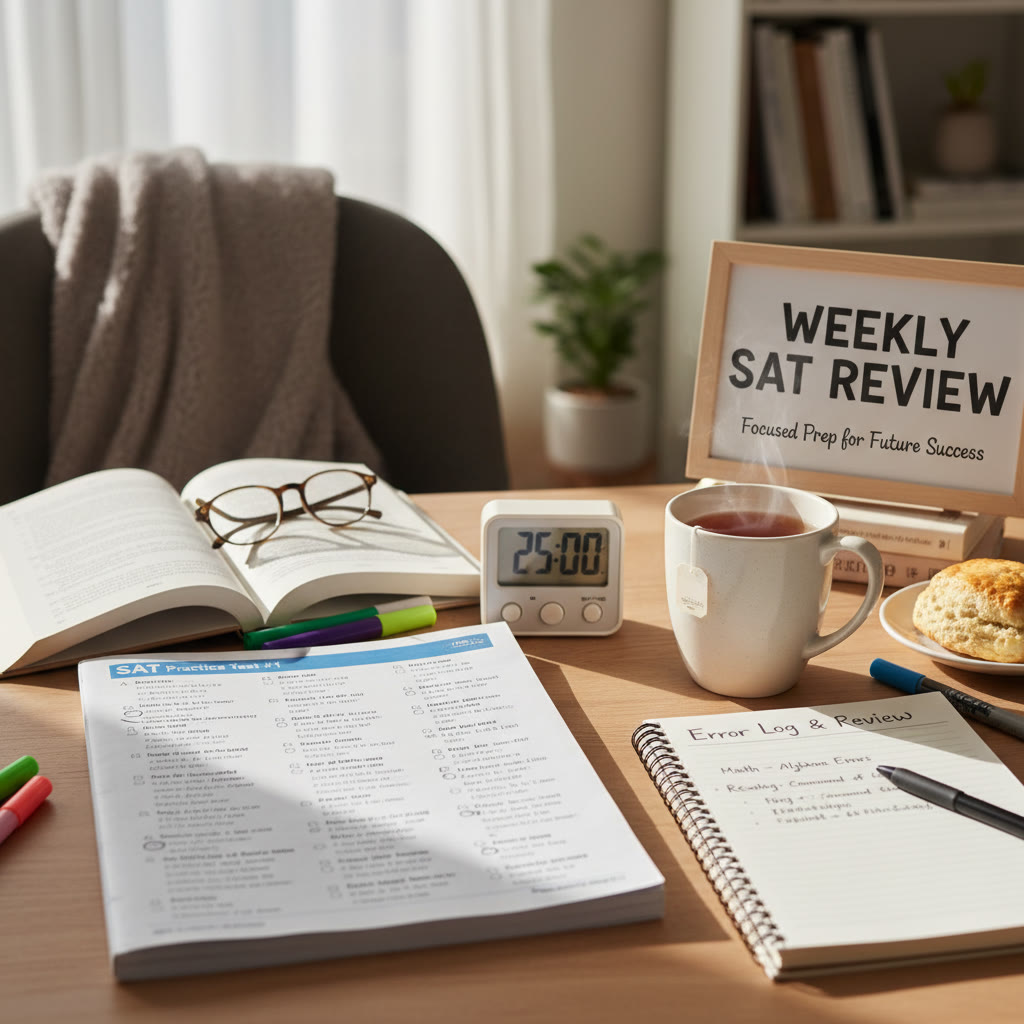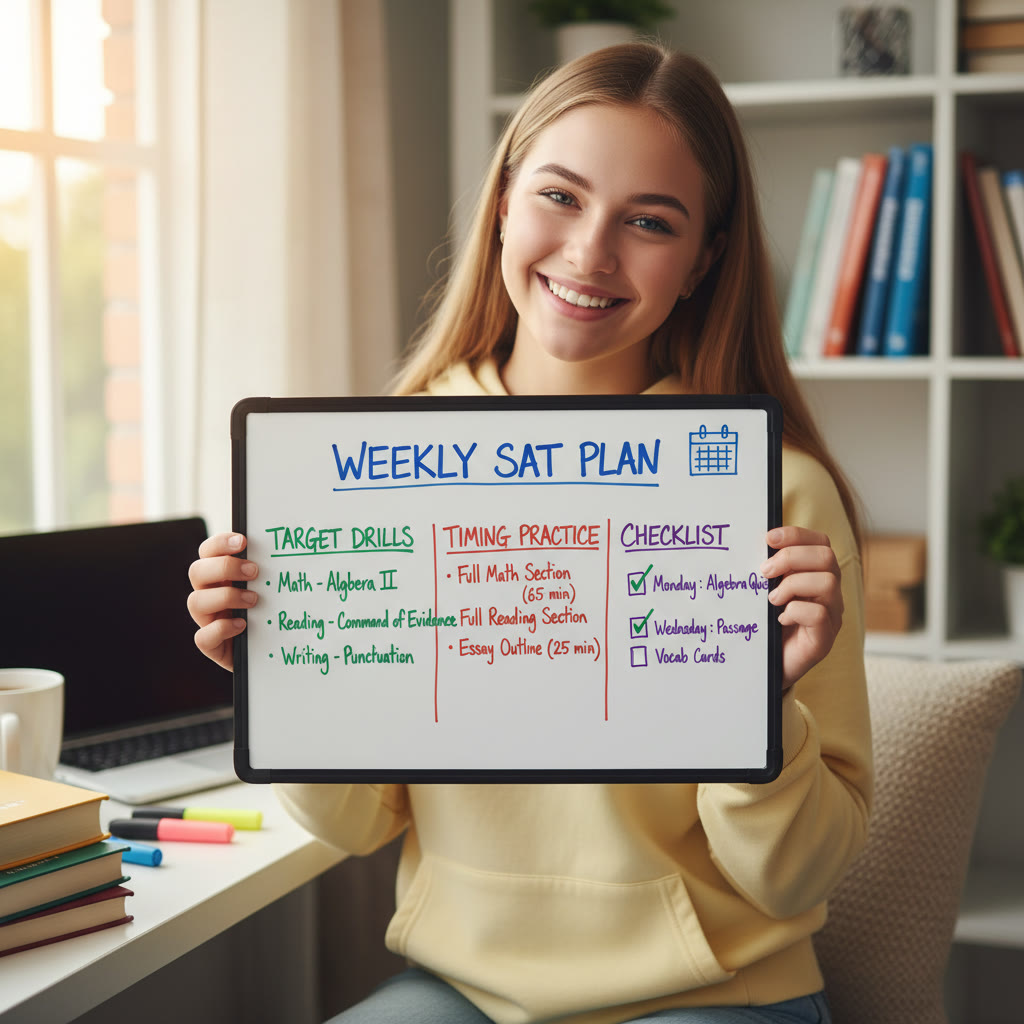Why a Weekly SAT Self-Review Session Works
Studying for the SAT can feel like trying to fill a bucket with a teaspoon — slow and steady wins the day. A weekly self-review session gives the teaspoon a purpose: consistent, deliberate practice that compounds. Instead of random homework and one-off practice tests, a structured weekly review lets you reflect, correct, and build habits that stick.
Think of it like training for a sport. You wouldn’t play a full game every day and never analyze your performance. You’d run drills, review film, and target weaknesses. The SAT is no different. A weekly self-review session is your film study — a dedicated block of time to look back on mistakes, reinforce strategies, and adjust plans for the coming week.
What You’ll Gain from a Weekly Review
- Clarity on patterns: spotting recurring error types (e.g., algebra slips or misreading passage structure).
- Better time management: refining pacing strategies through targeted practice.
- Confidence: turning frustrated guesses into deliberate strategies.
- Focused improvement: turning a long to-do list into a manageable list of actionable targets.
Before You Start: Materials and Mindset
Prepare the right tools and the right mindset. Your session won’t work if you’re half-asleep or scattered across five tabs. Gather the following:
- One recent full-length practice test (ideally taken under timed conditions) or several sectional practices.
- An error log (digital or paper) where you record question types, mistakes, and the fix.
- Official practice questions or trusted Q-banks for follow-up practice.
- Timer, scratch paper, and a comfortable workspace.
- A simple tracking sheet to log your scores and weekly goals.
Mindset matters: approach the session as a detective investigating the causes of mistakes rather than a judge handing out blame. Curiosity beats shame every time.
Structure: A Repeatable, 90–120 Minute Weekly Session
Here is a practical session that fits into most students’ weeks. The exact length can shrink or expand, but the order is the key — diagnose, drill, revise, plan.
| Segment | Time | Purpose |
|---|---|---|
| Warm-up & score logging | 10 minutes | Record scores, mood, and immediate reflections. |
| Mistake analysis | 30–40 minutes | Deep dive into wrong answers and ambiguous correct answers. |
| Targeted drills | 25–30 minutes | Practice question types you missed; short timed sets. |
| Strategy refinement & note-taking | 10–15 minutes | Write compact strategies to prevent repeat mistakes. |
| Weekly plan & accountability | 10–15 minutes | Set precise goals for the next week and pick checkpoints. |
Example: How That 90 Minutes Looks in Practice
Warm up by quickly entering the sectional subscores from your latest practice test. Then open your error log and start with one section: say, Math — your lowest score. Work backward from the test: for each wrong question, write the exact mistake type and the fix.
Spend a focused 10–12 minutes on two or three similar practice problems that reinforce the correct method. Avoid rushing; these are deliberate repetitions. Finish by writing a short strategy sentence you can read before the next practice test.
How to Analyze Mistakes — The Real Magic
Shallow mistake review is just redoing problems. Deep review asks: why did this happen? Break every error into three layers.
1) Surface Cause
Was it a careless error, a misread, or a knowledge gap? Example: You solved for x but mis-copied a coefficient — that’s careless. You skipped a negative sign — misreading. You didn’t recognize a trig identity — knowledge gap.
2) Cognitive Pattern
This is about mental habits. Do you tend to panic on multi-step algebra or freeze on complex sentence structure in Writing & Language? Cognitive patterns explain when and why you make surface errors.
3) Process Breakdown
Which part of your test process failed? Examples: failing to diagram reading passages, skipping the answer-check step, not estimating to eliminate answers, or not using substitution in Math problems where applicable.
- Write each error in the log as: Question ID → Surface Cause → Cognitive Pattern → Process Fix.
- Attach one action item per error: e.g., “Before submitting an answer, reread the question stem aloud” or “Practice 5 integer-factoring problems under 6 minutes.”
Designing Targeted Drills
After diagnosing your errors, design short drills that address the exact issue. A single drill should be 10–15 minutes with a narrow focus.
Examples of Targeted Drills
- If you misread comparative passage questions: do 8 passage-based comparison questions focusing on tone/author stance.
- If you keep losing points on quadratic factorization: set a 12-minute drill with 12 factorization problems using mixed coefficients.
- If commas and clause boundaries trip you up: isolate 10 Writing & Language questions about punctuation and sentence boundaries.
The aim is repetition with increasing accuracy and maintained timing. Track accuracy during the drill and note if speed or understanding is the primary obstacle.
Using an Error Log: A Simple Template
An error log turns questions into data you can act on. Keep it concise and consistent.
| Field | What to Write |
|---|---|
| Date | Date of the practice test or drill |
| Question | Test name/section/question number |
| Answer | Correct and your answer |
| Surface Cause | Careless, concept gap, time pressure, misread |
| Fix | One-sentence action item to prevent recurrence |
| Drill | Which follow-up drill you completed |
Keep the log in one place and review previous weeks’ entries during each session to check whether old errors recur. If an error keeps coming back even after drilling, the issue is likely either an incomplete learning step or insufficient spaced repetition.
How to Pace Weekly Progress: Metrics That Matter
Track metrics that tell you something useful. Raw score is important, but slice it:
- Sectional scores (Math, Reading, Writing & Language).
- Error-type frequency (e.g., algebra errors vs. arithmetic mistakes).
- Timing issues (e.g., 5–7 questions left unanswered consistently in Reading).
- Accuracy on drilled topics week over week.
| Week | Math | Reading | Writing | Notes |
|---|---|---|---|---|
| 1 | 590 | 610 | 590 | Weak on function notation and comma splices |
| 2 | 600 | 615 | 595 | Improved pacing but still rushed on long passages |
| 3 | 610 | 620 | 605 | Stabilized algebra; focus shifted to argument questions |
Small, consistent gains are normal. If your progress stalls, change the input: modify drills, extend study time, or get targeted feedback.
When to Bring in External Help — And How to Use It Wisely
Self-review is powerful, but sometimes a fresh pair of eyes accelerates progress. Consider expert help if:
- You’ve plateaued for 3–4 weeks despite disciplined review.
- Your self-analysis keeps pointing to the same vague problem (“I just get nervous”).
- You want a tailored study plan that optimizes the remaining weeks before test day.
Personalized tutoring — like Sparkl’s personalized tutoring — can fit naturally into a weekly routine. When used correctly, one-on-one guidance provides targeted strategies, tailored study plans, and expert feedback on your mistake patterns. The best tutors also leverage AI-driven insights to highlight hidden patterns in your practice data, then help you turn those insights into manageable action steps.
Sample Four-Week Cycle: How Reviews Build on Each Other
Here’s a simple four-week cycle that takes you from diagnosis to consolidation. Repeat the cycle, increasing difficulty and variation in practice questions.
| Week | Main Focus | Key Activities |
|---|---|---|
| 1 | Baseline & Diagnosis | Do a timed full test, create error log, identify 3 target weaknesses. |
| 2 | Targeted Drills | Daily short drills on weaknesses, weekly 90-minute self-review to analyze progress. |
| 3 | Mixed Practice & Timing | Take sectional timed tests, review timing errors, refine pacing strategies. |
| 4 | Consolidation & Real-World Simulation | Retake practice test, compare scores, adjust long-term plan or consider targeted tutoring sessions. |
After each cycle, celebrate small wins — a 10-point rise in Math, fewer careless errors, or a cleaner routine. Then set the next cycle’s targets.
Practical Tips and Small Habits That Make a Big Difference
- Keep the error log accessible: reviewing old entries before sleep helps memory consolidation.
- Use brief, timed micro-sessions during the week (15–20 minutes) to reinforce the weekly action items.
- Read one high-quality editorial or piece of nonfiction weekly to sharpen reading comprehension and vocab in context.
- Practice mental math daily to reduce careless algebra mistakes under pressure.
- Before each full practice test, skim your one-sentence strategies from previous reviews — these are your cheat-sheets for better habits.
Common Pitfalls and How to Avoid Them
Students often fall into the same traps. Here’s how to sidestep them.
Pitfall: Reviewing Only Right Answers
Why it fails: You consolidate luck, not skill. Fix: Focus on wrong answers and near-misses first — those reveal the highest ROI learning opportunities.
Pitfall: Vague Goals
Why it fails: “Improve Writing” is too broad. Fix: Set targeted goals like “Increase clause punctuation accuracy from 70% to 85% on weekly drills.”
Pitfall: Overloading Sessions
Why it fails: Long, scattered sessions lead to burnout. Fix: Keep weekly reviews focused, timed, and action-oriented.
Using Technology Smartly
Apps and AI tools can accelerate progress when used intentionally. Use them to log errors, generate targeted problem sets, and analyze timing trends. If you work with a program like Sparkl’s personalized tutoring, their expert tutors and AI-driven insights can transform raw practice data into a clear action plan — for example, flagging which question-types you repeatedly miss and recommending specific micro-drills.
But don’t let technology replace reflection. Automated reports are useful, but your weekly session is where you interpret those reports and decide what to do next.
Motivation: Keeping It Human
Improvement on the SAT isn’t linear. There will be plateaus and sudden jumps. Keep a short personal note in your weekly log about how you felt during the test, what surprised you, and one thing you did well. Small reminders of progress — like fewer careless errors or a more relaxed timing — do wonders for morale.
If you’re feeling stuck, consider a short consultation with a tutor or mentor. Sparkl’s tutoring offers one-on-one sessions that can renew momentum by translating your error patterns into concrete steps and encouraging accountability without pressure.
Final Checklist: Your Weekly Self-Review Template
- Record scores and basic stats (time, subsections, and emotional state).
- Analyze each wrong and ambiguous correct answer using the three-layer method.
- Create 2–3 targeted drills and complete at least one in the session.
- Write one sentence strategies for recurring error patterns.
- Record action items for the week (specific drills, readings, or timing experiments).
- Schedule 15-minute micro-sessions during the week to reinforce these actions.
Parting Thought: Consistency Over Intensity
Great SAT prep isn’t about burning out with marathon sessions; it’s about sustainable, reflective practice. A 90-minute weekly self-review, repeated with curiosity and small adaptations, moves the needle far more reliably than sporadic cramming. Use your weekly session as a quiet laboratory where mistakes are studied and turned into predictable gains.
And when you want to accelerate that cycle, bring in help strategically: a few targeted one-on-one sessions or an expert review that leverages AI-driven insights can cut months of guessing into weeks of clear progress. With a steady review practice and the right supports, your test-day confidence will follow the scores.


Ready to Try Your First Weekly Session?
Set a date, gather your materials, and treat the first session like an experiment. Keep notes, compare outcomes next week, and tweak. Over months, those tiny, deliberate adjustments translate into real score gains — and a calmer, more confident you on test day.
Good luck, and enjoy the detective work. Your mistakes are not failures; they’re the roadmap to better performance.



















No Comments
Leave a comment Cancel